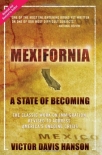Mexifornia: A State of Becoming, Victor Hanson [cool books to read .txt] 📗

- Author: Victor Hanson
Book online «Mexifornia: A State of Becoming, Victor Hanson [cool books to read .txt] 📗». Author Victor Hanson
Chicano, Latino, Hispanic, La Raza and all the other cachet words were as yet unknown. We never knew what malinchismo was (purported betrayal of the Mexican people) or Tio Tacos or pocbos (like Uncle Toms), much less La Raza Unida, MAPA or MEChA. I never heard the rubric "minority" until high school. "People of color" was two decades away; our biggest worry was avoiding the odious "colored people" and especially the N-word - which the Mexican kids were far more prone to use than the few whites against our half-dozen black schoolmates. Few of the professors today, whose smug moral universe is confined to the city limits of Berkeley, La Jolla, Palo Alto or Santa Barbara, would believe that in I960 using the N-word twenty miles south of Fresno in a rundown schoolyard would send any Mexican kid to the office in a way "gringo" or "wetback" would not.
Most fights were not racial. We in the miniscule white minority fought with and against Mexican-Americans. As I remember it, the great dividing line for most rumbles was whether you were born in Selma or Fresno. Fringe racists, of course, were around. Mr. Martinez, the fourth-grade teacher, told me in 1963, "Whitey is through in California. Some day, Victor, the whole town here will be Mexican, even the principal and the cops." He was, of course, prophetic, perhaps in ways he never imagined. As if to counter such chauvinism, Mrs. Wilson, a Texas native, complimented those in the art class who were "lighter than most from Mexico" and "could easily pass." I remember even at twelve thinking that her racial categories were absurd. Why should her own liver-spotted, wrinkled and blotted white complexion be the vaunted standard of hue, when half the Mexican girls in the class had beautiful, smooth olive skin that any Parisian connoisseur of beauty could call flawless? Yet on the other hand, it was Mexican students, not white, who insisted on calling Hector Bacho "chocolate" because of his nearly black skin. And they, not we, were cruel to Jeronimo Chapas, the only Puerto Rican among four hundred fifth-graders with truly black features, calling him "black Mexican" daily and even "Chino," as if he were some sort of bizarre Asiatic.
There was nothing of the contemporary multicultural model - bilingual aides, written and spoken communication with parents in Spanish, textbooks highlighting the majesty of the Aztecs and the theft of northern Mexico, or federally funded counselors to warn about drugs, gangs and teen pregnancy, and propagandize students that "The borders crossed us, not we the borders." Excused absences for catechism classes at the Catholic Church emptied our classrooms, giving us five or six Anglo Protestants a much-welcomed three-hour recess. (We also suffered through fish sticks on Friday, the public school's other concession to the vast Catholic majority.) Our principal worried that between Catechism classes, speech therapy and music appreciation, the students were losing two or three hours a week of reading and writing.
Growing up in multiracial rural California in the early 1960s, we did not merely review the nuts and bolts of the Constitution, or learn patriotic songs and brief sketches of Washington, Jefferson and Lincoln. Our discussions and lectures about American exceptionalism were not the triumphalism of a particular white race or Christian religion, but rather emphasized our own deep appreciation for just how distinctive the culture of the United States had proved to be over some two centuries. William Saroyan's short stories were much in vogue in our English classes. Much of his landscape was familiar, and his references to places in his native Fresno and the surrounding towns were known by most of us. Our teachers seemed to take for granted that Saroyan was critical of American society, and did not mind at all that non-Armenians in his stories could be portrayed as hysterically hypocritical and silly in their insularity and insensitivity toward darker others. None of us quite knew what the big deal about Armenians was anyway - since dozens of second- and third-generation Armenian-American kids were in our classes - only that they had apparently once, in ignorance, been treated unfairly as darker-skinned people.
Education was presented to everyone as the great escape from "the fields." The Japanese and Chinese had picked grapes and peaches at the turn of the century, before moving on to better lives. The Okies took their place before assimilating and leaving farm work. Armenians now owned the very farms they had once labored on. Education, unions, intermarriage, assimilation - all these forces and more made grape pickers into prosperous middle-class suburbanites. Mexicans, we trusted, were doing the same thing: those who were educated did not chop cotton; those who were not, did. And chopping cotton, while noble, paid little.
In fact, agricultural labor was presented as the great evil by our mostly Anglo teachers, many of whom themselves owned small vineyards! Cutting grapes was the specter by which they attempted to scare us into studying: "Okay, keep talking during class, Esperanza, and you will end up picking grapes the rest of your life." When farm-laboring parents at public schools week came into the classroom, the teachers politely but firmly reminded them that as fathers and mothers they had to monitor their children's homework





Comments (0)